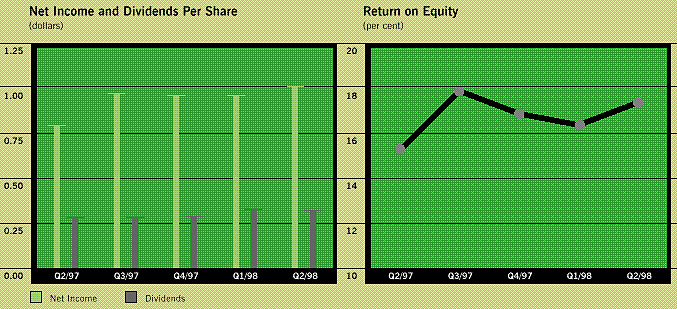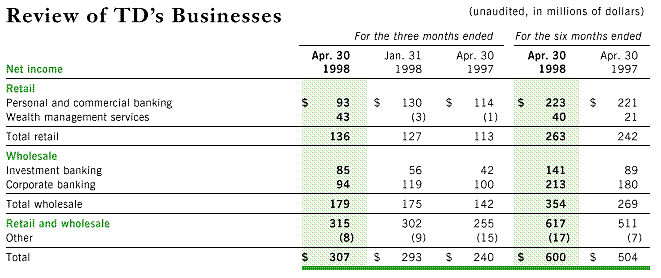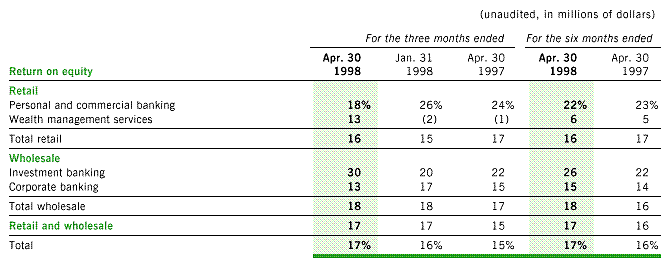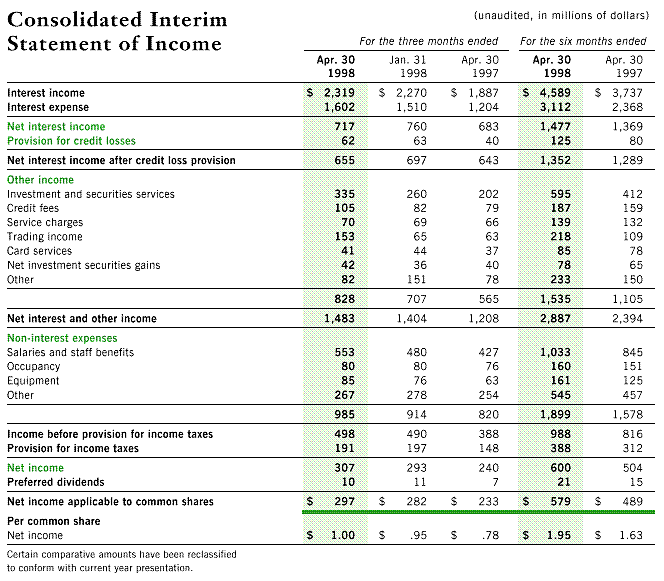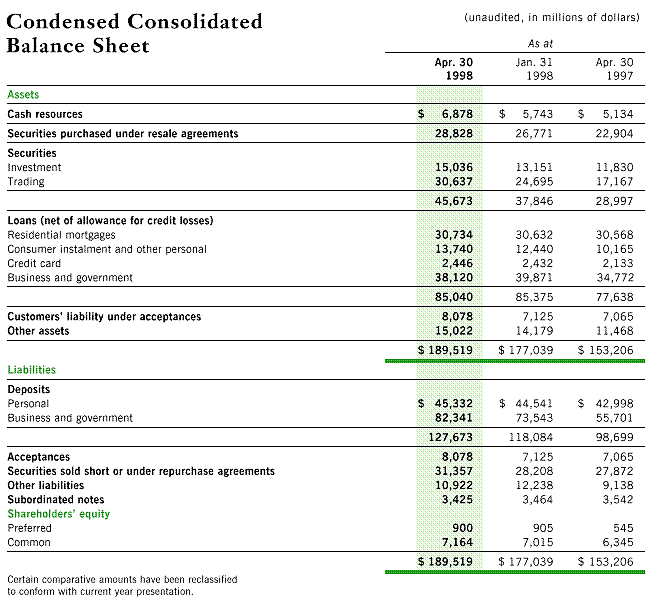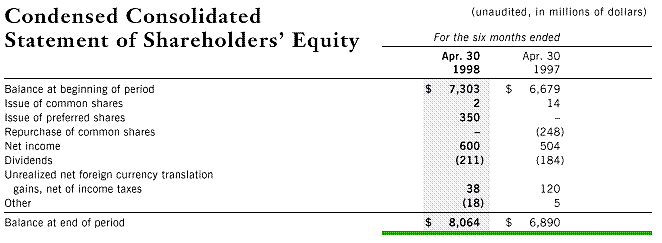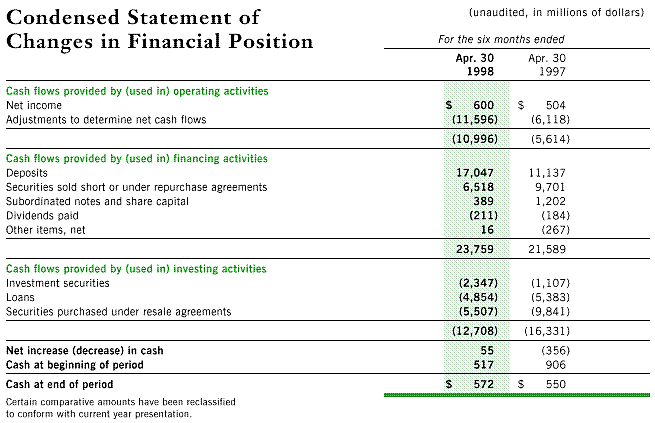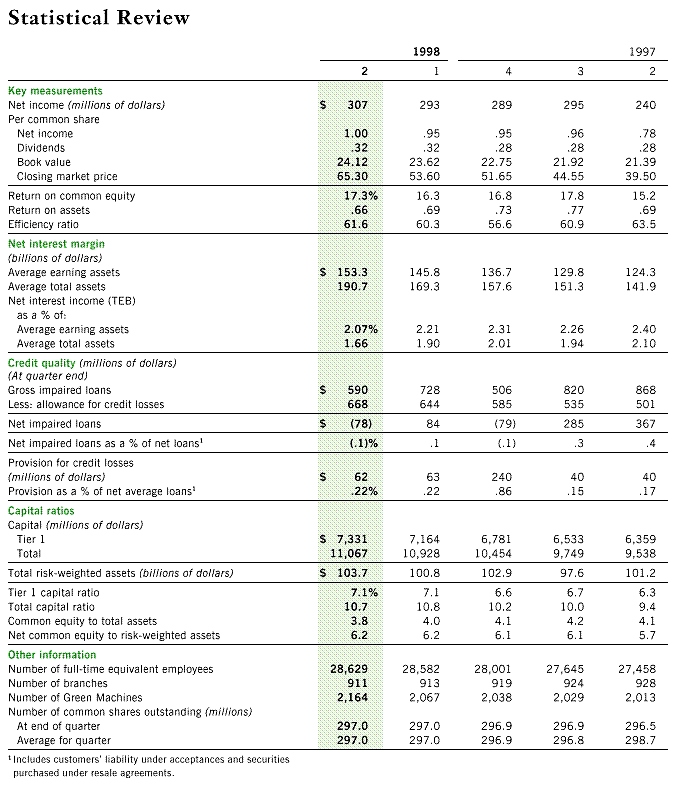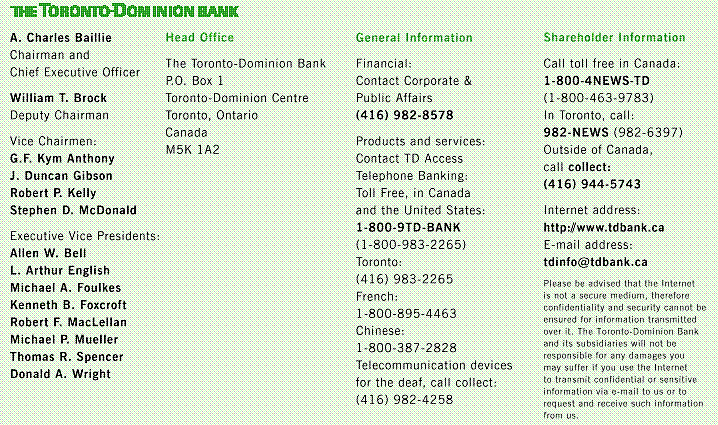Investor Relations
1998 Second Quarter Report to Shareholders
Table of Financial Highlights
Letter to ShareholdersPositioning TD for a new marketplaceWhile delivering a strong financial performance in the second quarter of 1998, we pursued an opportunity to enhance long term value for you - our shareholders - and for employees and customers. That opportunity is the proposed merger between TD and Canadian Imperial Bank of Commerce (CIBC), a major long-time competitor - a merger of equals such as that of the Bank of Toronto and the Dominion Bank which created TD in 1955. The proposed merger with CIBC will require approval by the Government of Canada, regulators, and you, our shareholders.This is a bold response to the radical transformation of our domestic marketplace implicit in the January announcement of the proposed merger of two of our other major competitors. As well, we have seen the massive changes wrought by new technologies and the impact of globalization, including the growing presence of powerful new foreign competitors in Canadian markets in recent years. These changes have eroded traditional banking franchises, particularly the banks' role in meeting the wealth management and credit needs of Canadians. By combining forces with CIBC, a strong institution with compatible strategies and complementary strengths, we will be better positioned to increase our investment in technology and training in response to changing markets. We will also have greater critical mass to leverage the growth of our wealth management and corporate and investment banking businesses in the U.S. markets and abroad. From the creation of Green Line in the eighties to the acquisitions of Central Guaranty and Waterhouse in the nineties, we have never hesitated to act quickly and decisively as attractive opportunities to generate long term growth - and respond to changing competitive conditions - have emerged. About the merger proposal and processUnder the terms of our agreement with CIBC, TD shareholders will receive 1.318 common shares in the new entity for every TD share held, while CIBC shareholders will receive one common share for every CIBC share held – giving TD shareholders 48.5% of the ownership of the merged bank. We will be combining our businesses as equal partners and the senior management team will be evenly balanced between TD and CIBC executives (with CIBC Chief Executive Al Flood serving as Chairman of the Board and TD Chief Executive Charlie Baillie serving as President and Chief Executive Officer). After extensive discussions by both management teams, we collectively agreed that the new bank will preserve TD's green colour (and distinctive associated brands such as Green Line and Green Machine) and will retain the name Canadian Imperial Bank of Commerce, which is more broadly representative of Canada.This merger is subject to regulatory approval by the Canadian Competition Bureau and the Minister of Finance, among others. The Government of Canada currently has a task force studying the future of the financial sector. The task force report is expected to be released this Fall, with public hearings to follow. We do not expect a decision from regulators until the Spring of 1999, at the earliest. Should regulatory approval be forthcoming, we will convene a special meeting of shareholders to vote on the proposal – and should shareholders approve, we will embark on the integration of the two banks. Preliminary planning is now underway to ensure a smooth transition. Government approval is not assured. Financial services reform is, quite rightly, a vitally important public policy issue that warrants full and fair debate. While we believe our proposed merger is in the public interest as it will help maintain a strong Canadian-based financial system, the federal government may determine otherwise and preclude all proposed bank mergers. We are fully prepared for such an outcome, which would mean the continuation of the traditional competitive relationships with our major competitors in our marketplace – a marketplace in which our successful strategies have given TD a competitive edge and generated a strong financial performance. Given the uncertainty of the outcome, our challenge – and that of all TD people – is to remain focused on pursuing our strategies and continuing to build our businesses, maintaining 'business as usual'. For many years at TD, that term has meant business as unusual. Constant evolution of our markets and technologies has meant a constant climate of change. TD has succeeded in this climate thanks to the responsiveness, focus and commitment of our people. They are our greatest strength and that strength will be a foundation of our bank in the future – whether we merge or continue independently. Highlights of the second quarterWe are pleased to report that during this momentous period, TD delivered record net income of $307 million and earnings per share of $1.00, up 28% from the previous year, despite substantially higher taxes. Through vigorous pursuit of our strategies for growth, our businesses, led by wealth management and investment banking, have achieved solid year-over-year gains in revenues as detailed in the Review of TD's Businesses section that follows. Of particular note, TD gained market share in personal deposits, personal loans, mortgages, credit cards and retail brokerage. As well, we have seen substantial growth in mutual funds and loan syndications.Among the operating highlights of the second quarter:
OutlookGiven TD's strengths and strategies, and continued solid economic growth in our key markets, we believe your Bank will continue to deliver good results in the second half of the year.
Toronto, May 28, 1998
Personal and Commercial BankingNet income for Personal and Commercial Banking declined $21 million from the same quarter last year with return on equity also falling 6 percentage points to 18%. This decrease was due to a 23 basis point decline in interest margins and a $42 million or 10% increase in expenses mainly due to growth businesses. The decline in margins resulted from increases in short-term market interest rates causing a further flattening of the yield curve, which largely eliminated earnings on the interest rate gap position. As a result, net interest income for the quarter increased only $4 million or 1% over the prior year. Average earning assets grew 7% as personal loans, residential mortgages, including securitizations, and commercial loans and bankers' acceptances continued to show strong growth of 19%, 12% and 12% respectively. The increased level of expenses arose from the continued expansion of electronic banking, insurance and asset-based financing businesses as well as increased investments in equipment and training.Compared to the prior quarter, net income declined by $37 million. This was primarily due to the negative impact on margins arising from the increased short-term rates in the quarter, and higher operating expenses resulting from customer activity during the RSP season coupled with the shorter quarter and the previously noted initiatives. Wealth Management ServicesWealth Management net income of $43 million increased $44 million over the prior year's level which included $29 million acquisition expense relating to the purchase of Pont. Retail brokerage and mutual fund assets under administration totalled $106 billion at April 30th, an increase of 80% from a year ago. After adjusting for the acquisition of Pont in the same quarter last year, return on equity remained relatively flat at 13% as improved results were offset by additional capital allocated to support both the addition of Kennedy Cabot and strong growth in margin balances.Net income improved $46 million from the prior quarter which included $25 million acquisition expense relating to the purchase of Rivkin Croll Smith. Brokerage commissions and mutual fund management fees continue to improve, increasing 26% from the first quarter. Bolstered investor confidence resulted in record trade volumes for Green Line and TD Evergreen, increasing 28% and 46% respectively from the prior quarter. TD Asset Management retail mutual fund volumes continued to grow with an increase of 11% in the quarter. Waterhouse has enjoyed tremendous growth as trading volumes increased 176% and the number of active customers was up 77% from a year ago. Electronic trading as a percentage of total trades has grown to 54% from 31% in the same quarter last year.
Investment BankingInvestment Banking more than doubled its net income compared to the same quarter last year to $85 million.Much of the success of the quarter can be attributed to our expansion and strong capital markets in the quarter. This was particularly evident in trading and fee income from fixed income products. Revenue from interest rate derivatives also improved significantly from a year ago with contribution from the relatively new credit derivatives business. Contribution from money markets more than doubled compared to last year as a result of strong growth in commercial paper programs. Domestic fixed income benefitted from strong trading results in Government of Canada bonds combined with improvements in fee income as we underwrote several corporate issues during the quarter. TD continues to build upon its strong position in the Eurobond market with revenues increasing substantially compared to a year ago. The high yield group is experiencing exceptional growth in its business. The institutional equities and structured finance businesses were able to take advantage of the increased activity in the global equity markets during the quarter resulting in improved trading income. The segment's return on equity improved to 30% during the quarter reflecting the higher net income. Corporate BankingCorporate Banking net income of $94 million decreased 6% compared to the same quarter last year despite net interest income increasing $12 million and other income increasing $25 million. The reduction in reported income was caused by a $15 million increase in the segment's provision for credit losses reflecting increased provisions based on the estimated annual average experience over a credit cycle and a $19 million increase in income tax expense due to higher rates. Credit quality remains high and the segment's impaired loans as a percentage of total loans are less than half last year's level. Total loans and acceptances increased by 12% from a year ago. Return on equity decreased slightly to 13% which was in line with lower net income.Fee income increased by 42% from a year ago as a result of higher loan and syndication fees. TD led several large credit facilities during the quarter which provided significant fee income. Revenue from syndications more than doubled compared to last year. Net income increased by $4 million from last quarter and return on equity is unchanged, when prior quarter results are adjusted for the gain on disposition of TD's payroll services business.
Review of Operating PerformanceDuring the second quarter your Bank generated record net income of $307 million. This is an increase of $67 million or 28% from the second quarter of 1997 and is $14 million or 5% better than last quarter. The 1997 results included a one-time after-tax expense of $29 million relating to our purchase of Pont Securities. The record net income is a result of very strong other income reflecting returns from our investments in wealth management businesses and our expansion of TD Securities. At $828 million, other income is 47% ahead of the same quarter last year.Earnings per share in the quarter were a record $1.00, $.22 or 28% higher than last year. Return on common equity was 17.3% in the quarter compared to 15.2% last year. On a cash basis, return on equity would be 19.6% this quarter compared to 19.2% last year. Net interest incomeOn a tax equivalent basis net interest income increased $46 million or 6% from the second quarter last year to $772 million this quarter. The growth in net interest income was a result of a 23% increase in average earning assets which grew to $153.3 billion from $124.3 billion last year. Earning assets growth continues to be primarily due to strong growth in trading securities and securities purchased under resale agreements, activities which support our increased investment banking businesses. While these assets have a much lower margin than other intermediation products, they do contribute to net income and have minimal credit risk, making them less capital intensive than other intermediation products. This change in the mix toward lower margin assets coupled with a flatter yield curve contributed to a 33 basis point decline in margin from the second quarter last year, which partially offset the positive effect of higher earning assets.Credit quality and provision for credit lossesCredit quality continues to be strong. This quarter net impaired loans once again fell below zero to minus $78 million at the end of the quarter. This is $445 million lower than second quarter last year and reflects an increased level of general reserves and the Bank's continued strong credit performance.The full year estimate for provision for credit losses in 1998 is unchanged from last quarter at $250 million and is based on establishing the total provision for credit losses at the estimated annual average experience over a credit cycle. In 1998 this provision is expected to contribute towards establishing additional general reserves after providing for all expected credit losses this year. One quarter or $62 million of the full year estimated expense was taken this quarter. Other incomeLed by our wealth management, investment banking and corporate banking businesses, other income had an exceptionally strong quarter generating $828 million in revenues. Other income was $263 million or 47% higher than the same quarter last year and continues to be broadly based. Investment and securities services contributed $133 million of the increase from last year, driven by our global discount brokerage businesses - Green Line, Waterhouse and Green Line Australia, our full service broker TD Evergreen, mutual funds and TD Securities. Compared to last year, total revenue including related net interest income was 105% higher for Waterhouse and 43% higher for TD Evergreen. Mutual fund revenue continues to be strong based on growth in assets under administration in both Canada and the U.S. Revenues this quarter increased $15 million or 41% from last year. TD Securities saw a $31 million increase in underwriting revenue and a $16 million increase in institutional equity sales revenue over last year. Also within TD Securities, equity and interest rate trading had an exceptionally strong quarter contributing $87 million to the increase in other income. This is a reflection of the strong capital markets in the quarter with good performance from our Eurobonds, high yield and equities businesses. Corporate credit fees also had a very good quarter with revenue increasing $24 million or 39% from last year.TD's investment portfolio of securities continued to perform well and $42 million in net investment securities gains were realized in the quarter. The surplus of market over book value of the Bank's securities portfolios at the end of the quarter was $965 million. This is an increase of $458 million from last year. Non-interest expensesExcluding the $29 million expense associated with our purchase of Pont Securities Inc. in the second quarter last year, total non-interest expenses grew 24% - in line with the 24% growth in total revenue. Strong revenue growth in our wealth management and investment banking segments was accompanied by $168 million of increased expenses which accounted for 21 percentage points of the increase. Additional expenses associated mostly with increased customer activity and investments in personal and commercial banking infrastructure account for the remaining increase.Our reported efficiency ratio this quarter improved 1.9 percentage points over last year to 61.6%. Excluding goodwill, our efficiency ratio was modestly higher at 61.0% versus 60.7% last year. Balance sheetAs at April 30, 1998 total assets were $190 billion which is $37 billion or 24% higher than a year ago. Growth in securities purchased under resale agreements, investment and other trading securities balances in support of our increased investment banking activity account for $23 billion of the increase and continues to be the main reason behind this strong growth. Loan growth continues to be healthy and is up 10% from last year. Residential mortgage loans, gross of $2.7 billion in securitizations during the year, grew 9% or $2.9 billion. Personal loan growth remains strong and is up 32% or $3.9 billion from last year. This growth demonstrates improved consumer confidence and an increase in our domestic market share. Personal loan growth also benefitted from growth in Waterhouse which has seen personal loans increase to $2.9 billion from $.9 billion in the second quarter of last year. In addition, business and other loans increased 10% or $3.3 billion over last year.Personal non-term deposits increased 15% or $2.9 billion over last year. Waterhouse contributed $2.3 billion of this increase. Indicative of the shift to higher cost sources of funding earning asset growth, wholesale deposits have increased 59% or $22.5 billion over last year. This is due mostly to the increase in investment banking activities. Mutual funds under management in Canada increased 20% or $2.5 billion over last year while personal term deposits declined 2% or $.5 billion from last year. Waterhouse Securities also continues to experience growth in mutual funds which increased 102% or $4.7 billion over last year. Total mutual funds under management at April 30, 1998 were $24.2 billion, an increase of $7.3 billion or 43% from last year. CapitalCommon equity increased $149 million in the quarter primarily due to net income after dividends of $202 million in the quarter partially offset by foreign currency translation losses due to the Canadian dollar strengthening, relative to other currencies, as at April 30, 1998 versus January 31, 1998.The ratio of net common equity to risk-weighted assets at 6.2% as at April 30, 1998 is unchanged from January 31, 1998 as we continue to actively manage our risk-weighted assets and capital requirements. During the quarter we insured a further $1 billion in conventional residential mortgages with Canada Mortgage and Housing Corporation and securitized $500 million in mortgages, which reduces the regulatory capital requirements for these loans. These events, together with the increase in common equity previously noted, offset the increase in risk-weighted assets from business growth. Our Tier 1 capital ratio remained at 7.1% while our total capital ratio declined modestly to 10.7% from 10.8% last quarter.
|


